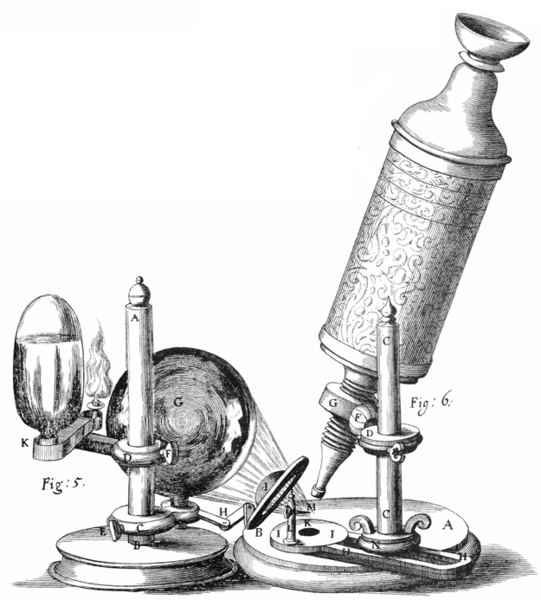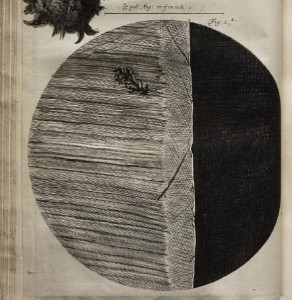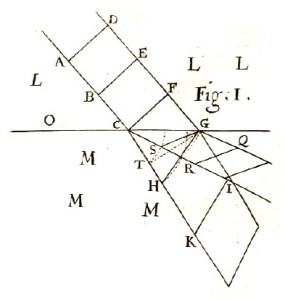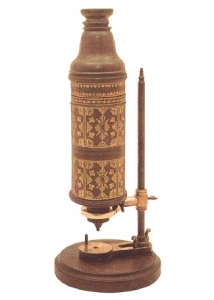Leibniz’s early reflections on natural history and experiment
Peter Anstey writes…
G. W. Leibniz visited England in late October 1676. While there he renewed his acquaintance with Henry Oldenburg, Secretary of the Royal Society, and showed him his calculating device. After a week’s visit he boarded a ship bound for the Continent on 29 October, but for various reasons the ship was delayed and he used his time while moored in the Thames to write a dialogue about the nature of motion.
This dialogue, recently translated in full for the first time, has a very interesting preamble about natural philosophical methodology. This preamble may well have been stimulated by his recent visit to London, for it mentions some of the leading ideas of the new experimental philosophy that was practised there and promoted by many Fellows of the Royal Society of which Leibniz was a foreign member.
The dialogue is between Pacidius, aka Leibniz, Gallantius, Theophilus and Charinus. Pacidius opens with a comment about the danger of looking for causes when one does natural history. (I am quoting from the translation of Richard Arthur, G.W. Leibniz: The Labyrinth of the Continuum: Writings on the Continuum Problem, 1672–1686, New Haven: Yale University Press, 2002.) We take it up from Gallantius’ reply:
GALLANTIUS: I have certainly often wished that observations of nature, especially histories of diseases, could be presented to us unadorned and free from opinions, as are those of Hippocrates, and not accommodated to the opinions of Aristotle or Galen or somebody more recent. For we will only be able to revive philosophy when we have solid foundations for it. (p. 133)
Gallantius focuses on natural histories of disease, but his point applies more generally to the project of Baconian natural history (described here) which, as Oldenburg repeatedly claimed, was to provide solid foundations for natural philosophy. Theophilus replies:
THEOPHILUS: I do not doubt that the royal road is through experiments, but unless it is levelled out by reasoning we will make slow progress, and will still be stuck at the beginning after many generations. (p. 133)
Theophilus here raises the issue of the relation between the gleanings from observation and experiments, which is the focus of natural history, and the need to theorise in order to get an understanding of nature. The comment about being ‘stuck at the beginning after many generations’ is prescient because, as we have pointed out before on this blog, one of the reasons that the Baconian program of natural history faltered in the late seventeenth century was because it had delivered so little in the way of stimulus to new natural philosophy. Robert Hooke was sensitive to this very point in his ‘Discourse of Earthquakes’:
tho’ the things so collected [by our natural historians] may of themselves seem but like a rude heap of unpolish’d and unshap’d Materials, yet for the most part they are so qualified as that they may be fit for the beginning, at least of a solid, firm and lasting Structure of Philosophy. (Posthumous Works, London, 1705, p. 329)
Theophilus continues:
… I am amazed at how many excellent observations we have …, at how many elegant experiments the chemists have performed, at what an abundance of things the botanists or anatomists have provided, which philosophers have not made use of, nor deduced from them whatever can be deduced.
PACIDIUS: But there does not yet exist a technique in natural philosophy for deducing whatever can be deduced from the data, as is done according to a definite order in Arithmetic and Geometry. … Once people have learnt to do this in natural philosophy … they will perhaps be surprised that many things were unknown to them for so long––which should not be put down to the laziness of the true method, which alone sheds light. (pp. 133/135)
Here Leibniz reveals that he was aware of the significant progress of the new experimental philosophy as applied in disciplines, such as chemistry, anatomy and botany, and at the same time the lack of progress in using this for developing a philosophy of nature. He puts it down to the lack of a method that is analogous to that in mathematics. The same lack of progress had been noticed by other critics of the new experimental philosophy, particularly the English wits, but rather than viewing this as a methodological deficiency they simply mocked the new natural philosophers in works such as Thomas Shadwell’s play The Virtuoso which appeared in 1676, the very same year as Leibniz’s visit.
Charinus, who speaks next in the dialogue, uses Pacidius’ observations as a segue into a discussion of the nature of motion, and so the methodological reflections tail off at this point. However, the little we do have gives us a fascinating window onto Leibniz’s views of the state and prospects of the new experimental philosophy with its emphasis on natural history in the mid-1670s.
Different concepts of the microscope in the 1660s
A guest post by Ian Lawson from the University of Sydney.
Ian Lawson writes…
Margaret Cavendish’s Observations upon Experimental Philosophy (1666) was a direct criticism of the Royal Society, largely focused on their most prolific work to that date – Robert Hooke’s Micrographia (1665). Cavendish was no fan of experimental philosophy generally, thinking it likely to lead to civil strife, and needing in any case to be guided by speculative thought, she criticised microscopes specifically for a few particular reasons:
- They’re difficult to make and use;
- They’re not very useful (Cavendish asks if observing a louse through a microscope can prevent it from biting); and, relatedly
- They distort nature.
This last, I would like to suggest, points to a different way of understanding and conceptualising the instrument to that of the Society microscopists (I am thinking particularly of John Wilkins, Christopher Wren, and Hooke).
Cavendish writes:
- I do not say, that no glass presents the true picture of an object: but only that magnifying, multiplying, and the like optic glasses, may, and do oftentimes present falsely the picture of an exterior object; I say, the picture, because it is not the real body of the object which the glass presents (pp. 50-51).
A louse, viewed under the microscope, looks like a lobster, and a sharp knife looks blunt. “[I]f the edge of a knife or the point of a needle were naturally and really so as the microscope presents them, they would never be so useful as they are” (p. 51). This is of course a direct reference to Hooke – a needle and a razor were the first two observations in his Micrographia.
Hooke likewise admits that if the razor were “really such as it appear’d through the Microscope, it would scarcely have serv’d to cleave wood, much less to have cut the hair of beards.” Unless, he continues, it were used
- after the manner Lucien merrily relates Charon to have made use of, when with a Carpenter’s Axe he chop’d off the beard of a sage Philosopher, whose gravity he very cautiously fear’d would indanger the oversetting of his Wherry (p. 5).
Hooke’s razor, though lacking a knife’s sharp edge, still has the capacity to rob a philosopher of his wisdom, by showing intuitive assumptions are unfounded. Cavendish appears to suggest there is one scale that an object exists ‘naturally’ at. On the other hand Hooke, Wilkins, and Wren emphasise the contingency of human senses:
- [I]f there were another Species of Intelligent Creatures in the World, they might have quite another kind of Apprehension of the same thing, and neither [theirs nor ours] perhaps as they ought to be.
(Hooke, General Scheme, or Idea of the Present State of Natural Philosophy, p. 8)
The Royal Society microscopists didn’t so much see themselves as altering the objects they were looking at, but rather modifying their own senses. They enter the micro-world, and present the razor as it would seem to someone the size of an insect. It may not retain its traditional use at this scale, but it is the observer who has been distorted rather than the object.
I’m not really sure how illustrative a difference this is to point out, but my feeling is it is tied in with a number of related themes and can possibly help to shed light on them: optimism for the new optical technologies; the new optics of Kepler and Descartes and the naturalisation of vision; experimental as opposed to mechanical philosophy; and Hooke’s approach to instruments more generally.
Conflating the Experimental and Mechanical Philosophies
Kirsten Walsh writes…
Recently I read Alan Shapiro’s paper, ‘Newton’s “Experimental Philosophy”’, in which he argues that
- the apparent continuity between Newton’s usage [of the term ‘experimental philosophy’] and that of the early Royal Society is, however, largely an illusion.
To support this claim, Shapiro argues that, whereas ‘experimental philosophy’ was used as a synonym for ‘mechanical philosophy’ by the early Royal Society, for Newton, the two terms had different meanings. This is demonstrated by the fact that Newton adopted the experimental philosophy, but not the mechanical philosophy.
Shapiro explains that the mechanical philosophy is characterised by adherence to some or all of the following theses:
- the world and its components behave like a machine; or, more strongly, the world can be described solely by the mathematical laws of mechanics; all causation is by contact action so that the immaterial, spiritual agents are banished; matter is composed of invisible corpuscles; and hypotheses about the properties and motions of these invisible corpuscles may be formulated to explain visible effects.
Here Shapiro is conflating mechanism and corpuscularianism. However, Peter Anstey explains in his recent book, John Locke and Natural Philosophy, that these are distinct (but related) philosophies. The leading idea of the mechanical philosophy is that natural phenomena should be explained by analogy with the functioning of machines. The corpuscularian philosophy is primarily a philosophy about the underlying nature of matter, whereby explanations of natural phenomena are constrained by appeal to the invisible corpuscles which constitute all material bodies. Thus, the former is a theory of explanation; the latter, a theory of matter. There is a significant amount of overlap between the mechanical and corpuscularian philosophies, for example the focus on shape, size, motion and texture. But, they are not interchangeable. For example, Anstey points out that it wasn’t the case that everyone who held a corpuscularian theory of matter was a mechanical philosopher.
In contrast, the experimental philosophy emphasises that we can only acquire knowledge of nature by first accumulating observations and experiments and then turning to theory and hypotheses. Thus, the experimental philosophy is a theory of method, which can be viewed as placing epistemic constraints on philosophical endeavours, as opposed to the explanatory constraints of the mechanical philosophy, or the ontological constraints of the corpuscularian philosophy. So, at least notionally, these are three distinct philosophical positions.
Shapiro argues that, in practice, the early Royal Society didn’t distinguish between these philosophical positions. As evidence, he cites a passage from the preface to Robert Hooke’s Micrographia in which Hooke runs together “the real, the mechanical, the experimental philosophy”. But if we look at Hooke’s other work for uses of the term ‘mechanical’, we find that he can and does distinguish the mechanical from the experimental.
When Hooke explicitly discusses experimental philosophy, he emphasises the importance of constructing natural histories. For example, in his ‘General Scheme’, where he sets out his “Method of Improving Natural Philosophy”, Hooke explains that the best way to proceed is according to the Baconian method of natural history. He says there are three “ways of discovering the Properties and Powers [of bodies]”:
- I. By the Help of the Naked Senses.
- II. By the Senses assisted with Instruments, and arm’d with Engines.
- III. By Induction, or comparing the collected Observations, by the two preceding Helps, and ratiocinating from them.
When he discusses III, Hooke explains that an understanding of mathematics and mechanics “will most assist the Mind in making, examining, and ratiocinating from Experiments”:
- Mechanicks also being partly Physical, and partly Mathematical, do bring the Mind more closely to the business it designs, and shews it a Pattern of Demonstration, in Physical Operations, manifests the possible Ways, how Powers may act in the moving resisting Bodies: Gives a Scheme of the Laws and Rules of Motion, and as it were enters the Mind into a Method of accurate and demonstrative Inquiry and Examination of Physical Operations. For though the Operations of Nature are more secret and abstruse; and hid from our discerning, or discovering of them, than those more gross and obvious ones of Engines, yet it seems most probable, by the Effects and Circumstances; that most of them may be as capable of Demonstration and Reduction to a certain Rule, as the Operations of Mechanicks or Arts.
Later in the same discussion, Hooke enumerates the different kinds of observations one should make when constructing natural histories:
- 25ly, To enquire and try how many Mechanical Ways there may be of working on, or altering the Proprieties of several Bodies; such as hammering, pounding, grinding, rowling, steeping, soaking, dissolving, heating, burning, freezing, melting, &c.
Hooke is using the term ‘mechanical’ in (at least) two different senses. In the first sense, the term describes the processes of machines; in the second sense, the term describes manual work. But he conflates neither of these with the experimental philosophy. They are distinct, albeit related, philosophies.
Previously on this blog we have claimed that some features of Newton’s early methodology, for example his early use of queries, suggest that he was influenced by the new experimental philosophy of the early Royal Society. I do not claim that Newton’s experimental philosophy is continuous with the experimental philosophy of the early Royal Society, so I do not take issue with Shapiro’s main claim. But I do take issue with his claim that the ‘mechanical philosophy’ and ‘experimental philosophy’ were considered by the early Royal Society to be synonymous.
Hooke’s Knowledge of Optics
This is a guest post by Ian Lawson.
Robert Hooke knew how light worked. He worked with the stuff day in day out during the early 1660s and in Observation IX of his Micrographia (1665) he presents quite a systematic theory of optics.
He presents his theory as the result of a startling observation about the colours of the rainbow observable in thin sheets of muscovy glass (mica). This observation he takes to be an ‘experimentum crucis’ against Descartes’ optical theory, ‘serving as a Guide or Land-mark, by which to direct our course in the search after the true cause of Colours’ (Micrographia, p. 54). His positive thesis starts by outlining a hypothesis about light based on some widely accepted principles (though I won’t go into the details here). This hypothesis he checks against more evidence, this time a glass globe filled with water. He finds his idea consistent with the phenomenon, while Descartes is again lacking. An ‘instantia crucis‘ this time – a sure sign he’s on the right track (ibid., p. 59).
To refine his theory, Hooke continues experimenting. Now he uses water in a long glass tube and sheets of muscovy glass split to varying thicknesses. He adds detail until he feels he can account for all kinds of colour phenomena. ‘By this Hypothesis there is no one experiment of colour that I have yet met with, but may be, I conceive, very rationally solv’d, and perhaps, had I time to examine several particulars requisite to the demonstration of it, I might prove it more than probable…’ (ibid., p. 69).
Hooke presents his theory in an ordered and structured way. First he disproves the leading existing theory, then puts forward his own hypothesis. He returns to experiment to check factual adequacy, and uses further trials to refine the general idea. Focusing on his theory as it is presented, though, makes several features of his account mysterious. Why is it tacked on to the end of an observation about colours in a mineral? Why should colour even be the main part of an optical theory? And given that it is, why does he never mention prisms?
What is worth noting is the experiments and observations Hooke makes. There are four primary apparatus he uses:
1. Muscovy glass
2. Glass lenses with water between them
3. Water globes
4. Glass vials filled with water.
Prisms, that paradigmatic optical experimentation device used by Descartes, Boyle, Power, and Newton in their experimenting about colour, are conspicuous by their absence. Rather, all of the experiments mentioned by Hooke are, in fact, part of his everyday set up for making microscopical observations. Numbers 2) and 4) are simply water microscopes, which he mentions using in the Preface to Micrographia. Number 3) is a scotoscope, used for concentrating light rays onto a small area to provide illumination, and also described in the Preface. And number 1) was Hooke’s preferred choice of microscope slide, as he explains when recounting his replication of Antoni van Leeuwenhoek’s observations in the late 1670s. It is unlikely that someone in possession of mica, ornate microscopes, and with connections among the fellows of the Royal Society as well as the instrument makers of London, was unable to obtain prisms with which to make experiments.
What is more likely is that, having spent four years making microscopical observations, Hooke stumbled again and again upon the incidental production of colours by his instruments. Chromatic aberration was a well known problem in microscopes and telescopes, which would not be solved until Dollond’s innovations in the eighteenth century. But using muscovy glass for specimen slides, and a water globe for illuminating his subjects, exposed Hooke two forms of colour production others may not have noticed. What’s more, in his Preface Hooke provides not only a detailed drawing of his primary instrument, but instructions on how it is made, and other versions suitable for other situations. Hooke doesn’t seem to have thought of his microscope as a static, finished product. Rather, he used one instrumental set up to make observations of distant objects such as the moon, and another to view things nearby and in his control. Even this could vary depending on whether the subject was translucent or opaque, and on the amount of light required to illuminate it. He notes trialling lenses made not just of glass, but resin, gum, oil, salt, and arsenic. All of this points to a man very aware of the behaviour of light and the process of refraction by which objects are magnified, and who was able to alter his instruments for the best results.
Some features of his theory are better explained by noting this likely route to Hooke’s knowledge of light, but a perhaps more difficult historical question is raised. Why did he present his observations as a constructed, systematic theory of colours rather than simply part of a history, as Boyle had done the previous year? It is likely the answer has something to do with ambition and rhetoric, and the role both Hooke and the other Fellows thought Micrographia would play in the early days of the Society.





